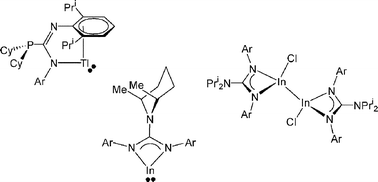Group 13 metal(i) and (ii) guanidinate complexes: effect of ligand backbone on metal oxidation state and coordination sphere†‡
Abstract
Reactions of

- This article is part of the themed collection: In honour of Jerry Atwood
* Corresponding authors
a Monash University, School of Chemistry, PO Box 23, VIC, Australia
b Cardiff University, School of Chemistry, Main Building, Cardiff, UK
Reactions of

 Please wait while we load your content...
Something went wrong. Try again?
Please wait while we load your content...
Something went wrong. Try again?
G. Jin, C. Jones, P. C. Junk, A. Stasch and W. D. Woodul, New J. Chem., 2008, 32, 835 DOI: 10.1039/B718799H
To request permission to reproduce material from this article, please go to the Copyright Clearance Center request page.
If you are an author contributing to an RSC publication, you do not need to request permission provided correct acknowledgement is given.
If you are the author of this article, you do not need to request permission to reproduce figures and diagrams provided correct acknowledgement is given. If you want to reproduce the whole article in a third-party publication (excluding your thesis/dissertation for which permission is not required) please go to the Copyright Clearance Center request page.
Read more about how to correctly acknowledge RSC content.
 Fetching data from CrossRef.
Fetching data from CrossRef.
This may take some time to load.
Loading related content
